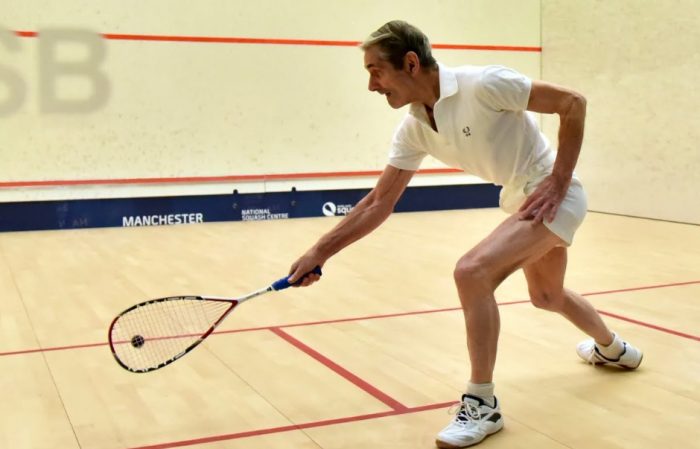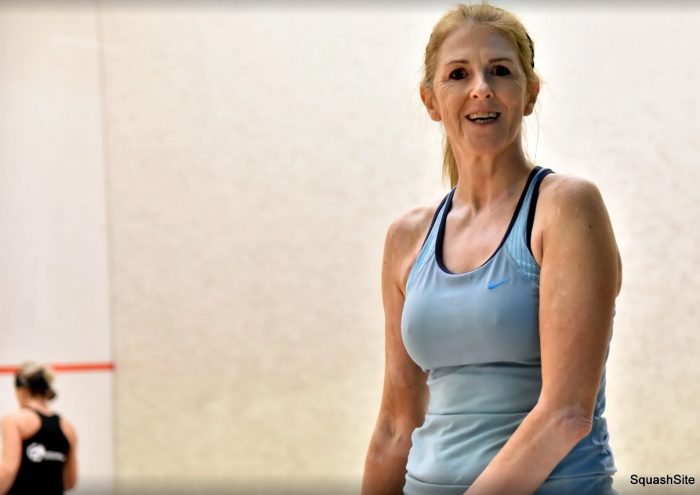Veterans sport is one of the fastest developing participation categories across the world, with an enormous growth in ‘Masters’ competition in a whole range of sports such as athletics, swimming, and cycling.
Squash is no exception, with a thriving series of age-graded events from over 35 right up to over 80 becoming established across the globe – the UK, in particular, has a fantastic circuit of masters tournaments spanning the length and breadth of the country. At club level, it’s also a very common sight nowadays to see more senior players battling it out on court in their weekly social, particularly so now as the physical benefits of the sport are officially approved.
As masters competition has become more established in different sports, along with increased participation there has been a consistent progressive improvement in standard and performance. The magnitude of improvements has been greater in the older age groups, in particular, gradually closing the gap in athletic performance between younger and older participants which has traditionally been considered to be much wider.
Similarly, in squash, the participation in age ranked tournaments from such players as Simon Parke, Nick Taylor, Peter Marshall, and Natalie Grainger – all ex-world top 10 level players – has seen a real boost to the standard of the masters’ circuit.

Older bodies are less tolerant of the stresses and strains of high-level sport and training however, and there is no escaping the fact that an age-related decline in performance does occur in most individuals around the mid-30s. The slope in declining performances increases notably after the age of 55 years, with a sharper decline in endurance-related factors than in speed for most older athletes, and a more pronounced overall decline in women’s performance than in that of men (though this may be due to a more significant drop in participation levels in sport for older women skewing the data).
So what are the exact physical effects of ageing, and how will they affect your squash?
With advancing age, structural and functional deterioration occurs in most physiological systems, even in the absence of any discernible disease. These age-related physical changes affect a broad range of tissues, organ systems, and functions.
The exact association between age and physiological function remains poorly defined however, and there are still no absolute definitive physiological markers that can be used to reliably predict the age of an individual (young or old) in the absence of other information – hence some of the issues recently in age classification of Pakistani players for certain junior squash tournaments.
The relationship between physical function and healthy ageing is thus complex and highly individualistic, and is further complicated by the fact that most studies into the topic have been done on sedentary populations as opposed to active sportsmen and women – prior physical activity levels are not always taken into account in studies into ageing, which can somewhat limit their relevance to more active populations, such as the regular squash player.
The American College of Sports Medicine (ACSM) has produced a list of a summary of the most widespread examples of physiological ageing that are typically agreed to take place from the mid-30s onwards, however, along with the usual age/time course of these changes in such cases that it is commonly known. Those most significant to the squash player and their on-court performance include:
- Maximum heart rate declines (by around 0.7 bpm per year)
- VO2max drops by around 9% per decade (a highly significant factor in endurance)
- Spine flexion decreases (by up to around 20% by age 70)
- Ankle mobility declines (by up to around 30 to 40% by age 70)
- Muscle size declines (by around 1 to 2% a year after age 30)
- Muscle strength and power decline (after age 40; lower body affected more than upper)
- Bone density drops (by around 0.5% a year after age 40, and 2-3% for women after menopause)
- Height decreases (by around 1cm a decade in 40s and 50s onwards)
- Body fat levels increase (from around age 30, though decline again after age 70)
- Volume of blood pumped with each beat of the heart decreases
- Body becomes slower to adjust oxygen uptake in response to activity
- Reaction speed slows down
- Capacity to store water reduces and thirst sensation weakens (increased risk of dehydration)
For a full list of the ACSM’s findings into the physiological effects of ageing see here.
It’s worth noting that just about every sign of ageing listed, including those most distinct factors of fat increase, muscle loss, and joint stiffening, are less pronounced in those who train regularly. Exercise alone may be insufficient to prevent all age-related decline, but it certainly leads to more sustained exercise capacity, lower levels of body fat, and to greater protection from many types of illness and disease.
Even many less obvious elements such as declining mental capacity, general cell deterioration, and degeneration of sight can be warded off by regularly training/exercising. High levels of physical activity and exercise, in general, can be said to be perhaps the most powerful ‘anti-ageing’ tactic we have – a lot of the physical decline we see with age stems as much from lessening levels of activity, as it does from purely physiological ageing factors.
 So while the masters’ squash player may slowly lose their athletic edge as compared to a younger opponent, they are putting themselves in a far better position in terms of overall well-being than their more sedentary counterparts. Older squash players are clearly better placed in respect to their health than their less active peers.
So while the masters’ squash player may slowly lose their athletic edge as compared to a younger opponent, they are putting themselves in a far better position in terms of overall well-being than their more sedentary counterparts. Older squash players are clearly better placed in respect to their health than their less active peers.
As a counterpoint, there is often believed to be an accumulation of ‘wear and tear’ that goes on in later life within the joints of those who have been athletes or highly active sport participants over the years. Studies that have looked at the instances of increased risk of knee osteoarthritis in sports such as hockey and football however, have concluded that older athletes’ likelihood of developing these issues is actually more connected with a ‘knock-on’ effect of previous injuries. For the keen sportsperson who has not suffered any serious knee injuries in their playing career, evidence suggests they are likely to have LESS risk of developing certain types of osteoarthritis and related joint pain than their sedentary counterparts, despite popular belief.
Another issue worth considering for those looking at masters squash from a more competitive perspective is how close they are to their athletic ceiling. While some physical deterioration such as that outlined by the ACSM is inevitable, simply by committing to a more structured physical training programme that properly addresses their individual strengths and weaknesses, veteran players can still often push on to be in a better state of conditioning than they were 10yrs previously, when they maybe weren’t quite as meticulous with their training.
There is clearly a physical decline we must deal with as we age, with certain unavoidable physiological changes taking place. Many of these though can be alleviated or lessened from both a health and a performance perspective through diligence and awareness and a commitment to a properly constructed training programme. We’ll take a look at training guidelines for older athletes in our next article, including advice on structuring a programme, and how best to strengthen the ageing body to help avoid injury.
Gary Nisbet
B.Sc.(Hons), CSCS, NSCA-CPT, Dip. FTST
SquashSkills Fitness & Performance Director
Watch: Fitness Focus For Masters Squash Players
In this series, SquashSkills Fitness & Performance Director, Gary Nisbet explains how to train efficiently and effectively as a Masters squash player.
Watch now